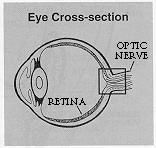|
All about glaucomaWhat is glaucoma? Glaucoma is a group of diseases in which the pressure in the eye is higher than
that particular eye can tolerate. The nerve fibers and blood vessels in the
optic nerve become compressed and can be damaged or destroyed. This is called
cupping. The optic nerve fibers are the "electrical cable" carrying
sight from the eye to the brain, and damage to these fibers impairs vision.
Glaucoma is a group of diseases in which the pressure in the eye is higher than
that particular eye can tolerate. The nerve fibers and blood vessels in the
optic nerve become compressed and can be damaged or destroyed. This is called
cupping. The optic nerve fibers are the "electrical cable" carrying
sight from the eye to the brain, and damage to these fibers impairs vision.
What controls the pressure in the eye?The pressure in the eye is determined by the balance of the fluid (called aqueous humor) coming into the eye and the fluid leaving the eye by the normal drainage channels (called the trabecular meshwork). The eye fluid (aqueous humor) is produced by the ciliary body, which lies behind the iris (the colored part of the eye). The fluid then passes forward through the pupil and exits the eye by a sieve-like drainage system (the trabecular meshwork) in the angle between the cornea and the iris.
Why is eye pressure high in glaucoma?For practical purposes, almost all glaucomas result from a decreased ability of fluid to leave the eye; the drainage mechanism is not working properly. A commonly used analogy is a faucet and a drain. In glaucoma the faucet is producing the correct amount of fluid, but the drain is not working properly so too much fluid accumulates within the eye and the pressure rises.Open-angle glaucoma versus angle-closure glaucomaGlaucoma can be separated into two categories. In open-angle, drain of the eye (the trabecular meshwork) is visible to the doctor inspecting the eye, and although it appears normal, it does not function normally. Because the trabecular meshwork is open and visible, the glaucoma is called open-angle.In angle-closure glaucoma the iris (the colored part of the eye) physically obstructs the drain of the eye. When the doctor looks in at the drain, he is unable to see it, because the iris is in the way. The iris is blocking the drain. This is why this type of glaucoma is called angle-closure glaucoma. Open-angle glaucoma often comes on slowly and is commonly called chronic glaucoma. Because at times angle-closure glaucoma comes on very rapidly, it is often referred to as acute glaucoma or acute angle-closure glaucoma. Are there other types of glaucoma?Yes, more complex forms of glaucoma exist. One form is combined mechanism glaucoma. This is where open-angle glaucoma and angle-closure coexist. The drain of the eye (trabecular meshwork) functions improperly as with open-angle glaucoma, and the angle between the iris and the cornea is narrow or closed as in closed-angle glaucoma.Congenital glaucoma is a disease which affects infants and is extremely rare. It is an inherited condition. The secondary glaucomas are another category. These forms of glaucoma are ones which are caused by other underlying eye diseases, such as eye inflammation, tumor, retinal detachment, diabetic eye disease, etc. An additional form is low tension glaucoma. In this variety of glaucoma, damage to the optic nerve can occur even at pressures in the eye which are considered normal for most people's eyes. Who is at risk for developing glaucoma?Glaucoma can occur in people of all ages from birth to very advanced years. It is more common in adults than children. Glaucoma most frequently occurs in people for no apparent reason. Certain groups of people, however, are known to be at a somewhat higher risk of developing glaucoma than others. These are people who have a family history of glaucoma, people who are nearsighted or diabetic, people suffering from other diseases of the eye and those who smoke.Factors which have not been found to affect the development of glaucoma include: coffee, alcohol and fluid restriction diets. Patients with glaucoma may use other medications, even those with glaucoma warnings (i.e., antihistamines, cold remedies, etc.) as long as they inform their doctors. Steroids, however, should not be used unless the prescribing doctor is specifically aware of the glaucoma. |
|
|